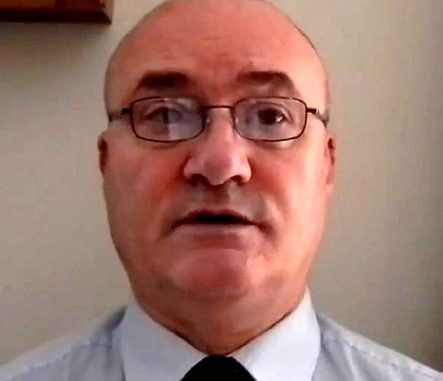
An Ottawa man facing charges of first-degree murder in the 2007 triple homicide of retired tax judge Alban Garon, Garon’s wife and a neighbour had a hatred of taxes and those who collect them and had earlier tried to lure Garon to his home, a Crown lawyer told an Ottawa courtroom. Ian Bush, 61, pleaded not guilty to first-degree murder charges in relation to the deaths of Garon, 77, his wife Raymonde, 73, and their friend Marie-Claire Beniskos, 78.
The three were found bound, gagged and beaten to death in the Garons’s 10th-floor apartment at 1510 Riverside Dr. on Saturday, June 30, 2007.
In his opening address Wednesday in an Ottawa courtroom to the jury at Bush’s murder trial, Crown counsel Tim Wightman outlined evidence he expected to present over the course of the two-month trial, including details of how police hit several investigative roadblocks.
Wightman described Bush’s hatred of taxation and his belief that taxation in all forms was “an abomination.”
Wightman said the Crown will present evidence from Bush’s acrimonious interactions with tax court in the 1990s and 2000s and his distrust of the Canada Revenue Agency, at the time known as Revenue Canada.
Bush sent letters to Revenue Canada, using “arrogant and insulting” language, and also sent a letter to Garon inviting him to a fictitious court proceeding, whose address was Bush’s home, Wightman told the court.
Victims had bags around heads
Alban Garon had extensive blunt-force injuries to his head, and a “blood letting” skull fracture, according to Wightman. Garon had a bag around his head and a noose tied around his neck and the bag, he said.
Raymonde Garon sustained a shoulder fracture and Beniskos had fractured ribs. Both women were hog-tied with bags tied over their heads. Wightman said the women died of suffocation.
Over the course of 10 days, police investigators and forensic experts took evidence from the apartment, which had no signs of struggle or overturned furniture, according to Wightman.
Police leads on shoe prints taken from the scene led nowhere, as did DNA evidence that was cross-referenced with the national DNA registry, said Wightman.
Investigation stalled
Police, he said, had video surveillance footage from nearby Hurdman bus station, but it yielded no immediate suspects.
A handyman at the Riviera condominium building told police he had an encounter with a serious looking man in the elevator, who he had never seen before, but he couldn’t positively identify the person who was also holding a bag.
Wightman said Raymonde Garon told friends about an odd encounter at her apartment, when a man claiming to be a delivery person, asked if her husband was home to receive a package.
When she said that her husband wasn’t home, but she could accept the package for him, the man said it was in his truck and that he’d return the next day.
Police investigators canvassed local delivery companies, but no leads emerged, according to Wightman.
DNA discovery in 2015
The break in the investigation, said Wightman, came early in 2015 when investigators obtained a DNA sample from Bush.
Wightman told the jury that an expert from the Centre of Forensic Sciences in Toronto will testify that Bush’s DNA matches DNA taken from the Garon apartment.
Wightman also told the jury that the shoe imprint taken from the apartment in 2007 will match the same kind of shoe found on a photo on a memory stick in the rafters of Bush’s home.
In Bush’s home, police also found a sawed-off 22 cal. rifle and ammunition, as well as knives, an iron bar which was taped on one end, and plastic bags which contained suffocation warnings, said Wightman.
Police also found a journal, in which Bush writes, “people who collect taxes are the lowest form of humanity. They are like the extortionist Jews,” said Wightman.
Police also found a numbered list, entitled “Process” along with identification cards for a government employee, a hydro employee, a DHL delivery person, and an RCMP identification card.
Police found a fanny pack in the home as well, said Wightman. He said Bush’s son will testify that he recognized his father in surveillance video from Hurdman station, because of his unique gait and that fanny pack.
Bush was formally charged with three counts of first-degree murder in February 2015. He was found fit to stand trial after a psychiatric assessment.
Wife’s brother found bodies
It was Raymonde Garon’s brother, Jean-Pierre Lurette, also a resident in the condo building, who found them.
He went to their apartment to check in on them that morning because they were not answering their phone. He found a light on and the door unlocked, according to Wightman.
Lurette is testifying in court Wednesday afternoon, speaking French through an English interpreter.
When asked by Wightman what he saw in the room, Lurette said, “three people bleeding on the carpet in the living room … I panicked and left quickly,” said Lurette, who returned to his condo and called 911.
Friend and sister testify
The last people to speak to Raymonde Garon and Marie-Claire Beniskos also testified Wednesday afternoon.
Gisèle Beauparlant told court she recalled speaking to her sister Beniskos between 9 and 9:30 on the morning of June 29, 2007. Pierrette Bourdeau, who told court she had known Raymonde Garon for over 50 years, said she last spoke to Garon on the phone at about 9:20 on the morning of June 29.
She said it was a short conversation, as the Garons were preparing to go to their cottage.
The trial is expected to last two months.
By Mario Carlucci
Source: cbc.ca


Be the first to comment